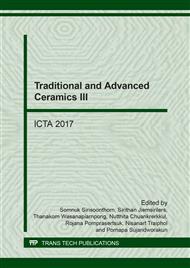p.122
p.127
p.133
p.139
p.145
p.151
p.157
p.164
p.170
Effect of the Addition of ZrSiO4 on Alkali-Resistance and Liquidus Temperature of Basaltic Glass
Abstract:
Basalt fiber has been used as a reinforced material in cement-based materials because it has higher mechanical strength and cheaper than common silicate based glass-fibers. However, silicate-based glass fibers have low alkali resistance especially in cement matrix composite. In this work, we studied the improvement of alkali resistance by addition of zirconium silicate (ZrSiO4) in original basalt glass composition. The batch of basalt glass with additional ZrSiO4 contents of 0.00, 2.50, 5.00, 7.50 and 10.00 wt% were melted at 1500 °C. The liquidus temperature (TL) is important in for the fiber glass manufacturing. It need to formulate glass composition which requires a lower melting temperature and is crystallization resistant. TL as a function of composition is usually determined experimentally. In this study, glassy phase was determined by X-ray Diffraction (XRD). The glass transition temperature (Tg), the crystallization temperature (Tc) and TL were analyzed by Differential Thermal Analysis (DTA). The results found that the addition of ZrSiO4 in a basalt glass batch increased Tg while Tc of each sample was closed to original basalt fiber. Moreover, the alkali resistance of these glasses increased with an increasing of ZrSiO4 content. However, excessive ZrSiO4 contents (7.50 and 10.00 wt%) resulted in crystallization of ZrO2 which separated from glassy phase.
Info:
Periodical:
Pages:
145-150
Citation:
Online since:
April 2018
Keywords:
Price:
Сopyright:
© 2018 Trans Tech Publications Ltd. All Rights Reserved
Share:
Citation:


